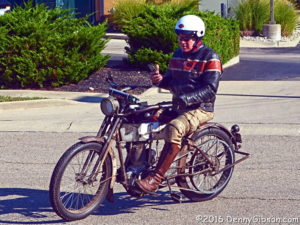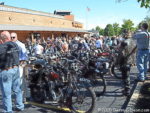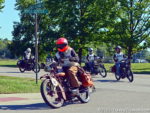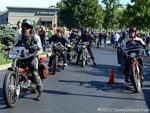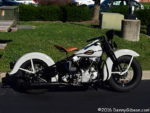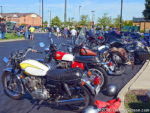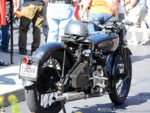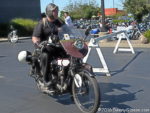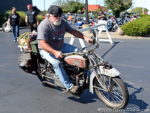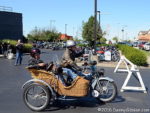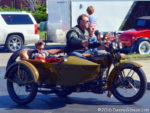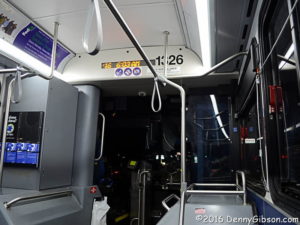 On Tuesday, I climbed aboard a Cincinnati city bus for probably the first time, other than some event specific shuttles, since 1970. Prior to taking a job in South Lebanon near the end of 1970, I worked downtown and often rode the bus from Pleasant Ridge and, before that, Clifton. I don’t believe bus service extended much beyond Pleasant Ridge in 1970. Probably Kenwood. Possibly Montgomery. Now buses run all the way to Kings Island, just a couple miles short of that South Lebanon job, but they don’t run often. Their purpose is to connect people with jobs so there is a flurry at the start of the work day and another at the end. Little in between and even less on weekends. I’ve long thought of heading downtown on a bus but the sparse schedule put me off. Boarding a bus in the morning essentially means being gone for the rest of the day. That’s not really a problem, of course. It happens often. Committing to it in advance and knowing that there will be no car a shortish walk away is somewhat different, however.
On Tuesday, I climbed aboard a Cincinnati city bus for probably the first time, other than some event specific shuttles, since 1970. Prior to taking a job in South Lebanon near the end of 1970, I worked downtown and often rode the bus from Pleasant Ridge and, before that, Clifton. I don’t believe bus service extended much beyond Pleasant Ridge in 1970. Probably Kenwood. Possibly Montgomery. Now buses run all the way to Kings Island, just a couple miles short of that South Lebanon job, but they don’t run often. Their purpose is to connect people with jobs so there is a flurry at the start of the work day and another at the end. Little in between and even less on weekends. I’ve long thought of heading downtown on a bus but the sparse schedule put me off. Boarding a bus in the morning essentially means being gone for the rest of the day. That’s not really a problem, of course. It happens often. Committing to it in advance and knowing that there will be no car a shortish walk away is somewhat different, however.

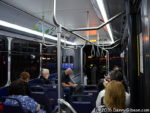 I decided to go for the first run of the day. The route starts about a block from my home and, as can be seen in the up top photo, the bus arrived and I was on board — alone — a little before the 6:07 departure. There are two other pickup points, both a little to the north, before the bus hits the southbound expressway for downtown. Four passengers were added at the first one and sixteen at the second. The second was at Kings Island where I tryed to take a picture of the distant sign in the dark. Once on I-71, everyone, except the driver and a lady knitting, had their eyes on their phone or an e-reader.
I decided to go for the first run of the day. The route starts about a block from my home and, as can be seen in the up top photo, the bus arrived and I was on board — alone — a little before the 6:07 departure. There are two other pickup points, both a little to the north, before the bus hits the southbound expressway for downtown. Four passengers were added at the first one and sixteen at the second. The second was at Kings Island where I tryed to take a picture of the distant sign in the dark. Once on I-71, everyone, except the driver and a lady knitting, had their eyes on their phone or an e-reader.
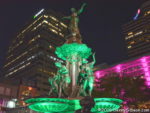
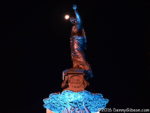 Total ride time was almost exactly one hour and I arrived downtown just a few minutes past 7:00. I spent a little time on Fountain Square which is in minor disarray as the skating rink is put in place for the winter. The moon, just two days past full, plays the part of a halo for the fountain. It has been drained of water but still looks good and will look even better before the day ends.
Total ride time was almost exactly one hour and I arrived downtown just a few minutes past 7:00. I spent a little time on Fountain Square which is in minor disarray as the skating rink is put in place for the winter. The moon, just two days past full, plays the part of a halo for the fountain. It has been drained of water but still looks good and will look even better before the day ends.
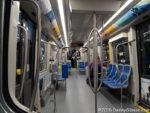
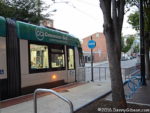 I boarded the day’s second form of public transport next to Fountain Square. When I rode the Cincinnati Bell Connector during its inaugural weekend, it was always full. Today, it carried just one passenger when I boarded at Fountain Square. It was a handicapped lady and I got to watch her drive her electric scooter directly from the car to the platform when she exited a few stops before I did. Pretty slick.
I boarded the day’s second form of public transport next to Fountain Square. When I rode the Cincinnati Bell Connector during its inaugural weekend, it was always full. Today, it carried just one passenger when I boarded at Fountain Square. It was a handicapped lady and I got to watch her drive her electric scooter directly from the car to the platform when she exited a few stops before I did. Pretty slick.
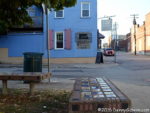
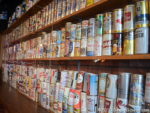
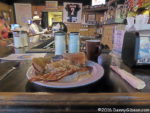 I had thought to have breakfast at the recently reopened (after a fire) Tucker’s but discovered that they are closed on Mondays and Tuesdays. I substituted the even older (1936 vs. 1946) Dunlap Cafe. It’s just a block away from the northernmost streetcar stop at Rhinegeist Brewery. Besides good and cheap eats, the Dunlap has an impressive beer can collection that includes several from Olde Frothingslosh. In the past, I hadn’t paid much attention to the little park across the street but the benches caught my eye today. I’m guessing that nearby residents are responsible for the tiles.
I had thought to have breakfast at the recently reopened (after a fire) Tucker’s but discovered that they are closed on Mondays and Tuesdays. I substituted the even older (1936 vs. 1946) Dunlap Cafe. It’s just a block away from the northernmost streetcar stop at Rhinegeist Brewery. Besides good and cheap eats, the Dunlap has an impressive beer can collection that includes several from Olde Frothingslosh. In the past, I hadn’t paid much attention to the little park across the street but the benches caught my eye today. I’m guessing that nearby residents are responsible for the tiles.
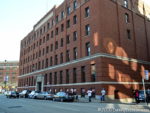
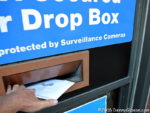 I will be traveling on November 8 so, for the second time in my life, I won’t be physically going to the polls on election day. I figured out which streetcar stop was closest to the Board of Elections location and set off on the next train to drop off my absentee ballot. A small-world moment occurred along the way. At an intermediate stop, friend, blogger (Queen City Discovery), and author (Fading Ads of Cincinnati) Ronny Salerno stepped aboard and we got to chat until he stepped off one stop before mine. At the ballot drop box, a lady in front of me posed for a selfie with her ballot in hand and the box as background then offered to take my picture dropping the envelope. I thanked her for the offer but opted for just a shot of my hand and ballot.
I will be traveling on November 8 so, for the second time in my life, I won’t be physically going to the polls on election day. I figured out which streetcar stop was closest to the Board of Elections location and set off on the next train to drop off my absentee ballot. A small-world moment occurred along the way. At an intermediate stop, friend, blogger (Queen City Discovery), and author (Fading Ads of Cincinnati) Ronny Salerno stepped aboard and we got to chat until he stepped off one stop before mine. At the ballot drop box, a lady in front of me posed for a selfie with her ballot in hand and the box as background then offered to take my picture dropping the envelope. I thanked her for the offer but opted for just a shot of my hand and ballot.
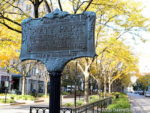
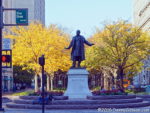 There is also something of a coincidence involved here. After dropping off my ballot, I walked back toward the center of town with no real destination in mind. I reached this park, Cincinnati’s oldest, by chance and the coincidence is that I recently read a blog post about the man who donated it to the city. Until a few years ago, I sort of assumed this was Garfield Park because of the statue of our twentieth president. It’s real name is Piatt Park. I’m sure that reading Cincinnati’s Richest Man Died In Debtor’s Prison a week or so ago has a lot to do with my taking and posting these pictures. A statue of our ninth president, William Henry Harrison, stands at the other end of the park. Combined, the two presidents honored here served less than eight months. Harrison 32 days, Garfield 200 days.
There is also something of a coincidence involved here. After dropping off my ballot, I walked back toward the center of town with no real destination in mind. I reached this park, Cincinnati’s oldest, by chance and the coincidence is that I recently read a blog post about the man who donated it to the city. Until a few years ago, I sort of assumed this was Garfield Park because of the statue of our twentieth president. It’s real name is Piatt Park. I’m sure that reading Cincinnati’s Richest Man Died In Debtor’s Prison a week or so ago has a lot to do with my taking and posting these pictures. A statue of our ninth president, William Henry Harrison, stands at the other end of the park. Combined, the two presidents honored here served less than eight months. Harrison 32 days, Garfield 200 days.
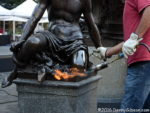
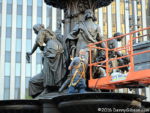 Fire on the fountain. Apparently if you need to clean something big and bronze, a torch and a brush is the way to go. The workmen told me that the 145 year old Tyler Davidson Fountain (a.k.a. The Genius of Water) gets this treatment twice each year. Good ventilation, I suspect, is also important.
Fire on the fountain. Apparently if you need to clean something big and bronze, a torch and a brush is the way to go. The workmen told me that the 145 year old Tyler Davidson Fountain (a.k.a. The Genius of Water) gets this treatment twice each year. Good ventilation, I suspect, is also important.
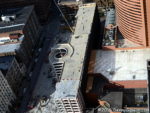
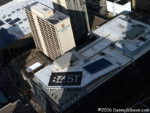
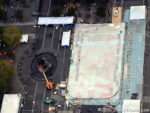 On impulse, I ducked into the Carew Tower and rode the elevator to the observation deck for a different view of the torch & brush guys. When I was last here, in November of 2014, the ice rink was in place and in use. Today workers were still assembling it. 84.51° is both the name and longitude of the marketing company that
On impulse, I ducked into the Carew Tower and rode the elevator to the observation deck for a different view of the torch & brush guys. When I was last here, in November of 2014, the ice rink was in place and in use. Today workers were still assembling it. 84.51° is both the name and longitude of the marketing company that was spun off from became a subsidiary of (see first comment below) grocery giant Kroger last year. The third picture is of the mid-demolition Pogue’s Garage which, by coincidence, I recently read about in an article whose author, by coincidence, I ran into earlier in the day.
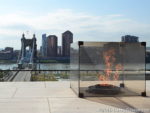
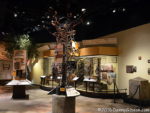
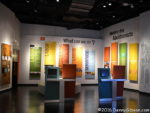 Visiting the National Underground Railroad Freedom Center was something I’d tentatively planned to do and walking down to it from the Carew Tower worked into my day quite nicely. One reason for wanting to visit today was the center’s participation in the current Foto Focus Cincinnati. I very much enjoyed the Foto Focus exhibits but took no pictures of them. The river beyond the center’s Eternal Flame was once the boundary between slavery and freedom. Construction of the suspension bridge that crosses it was interrupted by the Civil War. The third pictures shows one of the displays reminding visitors that forms of slavery still exist in the world today.
Visiting the National Underground Railroad Freedom Center was something I’d tentatively planned to do and walking down to it from the Carew Tower worked into my day quite nicely. One reason for wanting to visit today was the center’s participation in the current Foto Focus Cincinnati. I very much enjoyed the Foto Focus exhibits but took no pictures of them. The river beyond the center’s Eternal Flame was once the boundary between slavery and freedom. Construction of the suspension bridge that crosses it was interrupted by the Civil War. The third pictures shows one of the displays reminding visitors that forms of slavery still exist in the world today.
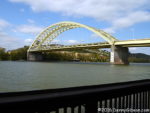

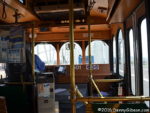 The day’s third flavor of mass transit picked me up just outside the Freedom Center. Operated by the Transit Authority of Northern Kentucky, the Southbank Shuttle connects Newport and Covington, Kentucky, with Cincinnati’s riverfront. I rode it to near the Beer Sellar on Newport’s Riverboat Row but found it not yet open. I ended up sipping a beer on Hooters’ deck.
The day’s third flavor of mass transit picked me up just outside the Freedom Center. Operated by the Transit Authority of Northern Kentucky, the Southbank Shuttle connects Newport and Covington, Kentucky, with Cincinnati’s riverfront. I rode it to near the Beer Sellar on Newport’s Riverboat Row but found it not yet open. I ended up sipping a beer on Hooters’ deck.
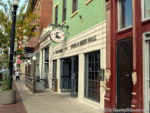
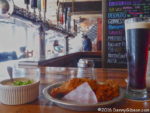 There are several new Cincinnati restaurants I’ve yet to try and today it was The Eagle‘s turn. The Southbank Shuttle took me to Fountain Square and the Cincinnati Bell Connector took be to within a couple blocks of The Eagle. It’s a place known for its fried chicken and it did not disappoint. It was accompanied by “spicy hot honey” that reminded me of how, just a few blocks away, The Genius of Water was being cleaned. I’m an admitted wimp and I know that what I thought fiery others would think just right or even mild but it was not for me. Properly warned, I sampled the honey with small drizzles on a couple of bites then put it aside and enjoyed the chicken and the spicy — but not spicy hot — cheese grits.
There are several new Cincinnati restaurants I’ve yet to try and today it was The Eagle‘s turn. The Southbank Shuttle took me to Fountain Square and the Cincinnati Bell Connector took be to within a couple blocks of The Eagle. It’s a place known for its fried chicken and it did not disappoint. It was accompanied by “spicy hot honey” that reminded me of how, just a few blocks away, The Genius of Water was being cleaned. I’m an admitted wimp and I know that what I thought fiery others would think just right or even mild but it was not for me. Properly warned, I sampled the honey with small drizzles on a couple of bites then put it aside and enjoyed the chicken and the spicy — but not spicy hot — cheese grits.
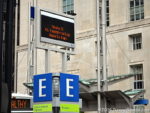 Had I walked directly to to the streetcar station after eating, I could have boarded almost immediately. Instead, I watched a train stop and continue as I strolled through Washington Park. I strolled on and caught the next one after only a few minutes. Time to the next car is normally displayed at each station but that wasn’t the case at this particular station at this particular time. The wait was around ten minutes. At my three previous boardings, displayed times had been 8, 6, and 12 minutes. The first ride of the day was the only time I entered a nearly empty car. The others were maybe a third to half full. I snapped the photo, showing that my ride home was four minutes away, about a dozen minutes after I arrived at the stop near Fountain Square. The ride back to a block from my home would cost $4.25. I’d used a free ride pass (received when I signed up for Cincy EZRide) for the ride into town. EZRide supports the purchase and use of Metro Bus and Cincinnati Bell Connector tickets from both Apple and Android smart phones. I purchased and activated my $2 all day Connector pass with it although I was never called on to show the pass. Each Southbank Shuttle ride costs $1. Even without an introductory free ride I can go from my home near Kings Island to the northern bits of Over the Rhine to Riverboat Row on the south side of the Ohio River and back home again for $12.50 ($4.25+$2+$1+$1+$4.25). The last route 71 bus leaves the Fountain Square area at 5:30 so it won’t work for a normal time dinner or an evening event but it’s a very sensible way to spend a day in the big city.
Had I walked directly to to the streetcar station after eating, I could have boarded almost immediately. Instead, I watched a train stop and continue as I strolled through Washington Park. I strolled on and caught the next one after only a few minutes. Time to the next car is normally displayed at each station but that wasn’t the case at this particular station at this particular time. The wait was around ten minutes. At my three previous boardings, displayed times had been 8, 6, and 12 minutes. The first ride of the day was the only time I entered a nearly empty car. The others were maybe a third to half full. I snapped the photo, showing that my ride home was four minutes away, about a dozen minutes after I arrived at the stop near Fountain Square. The ride back to a block from my home would cost $4.25. I’d used a free ride pass (received when I signed up for Cincy EZRide) for the ride into town. EZRide supports the purchase and use of Metro Bus and Cincinnati Bell Connector tickets from both Apple and Android smart phones. I purchased and activated my $2 all day Connector pass with it although I was never called on to show the pass. Each Southbank Shuttle ride costs $1. Even without an introductory free ride I can go from my home near Kings Island to the northern bits of Over the Rhine to Riverboat Row on the south side of the Ohio River and back home again for $12.50 ($4.25+$2+$1+$1+$4.25). The last route 71 bus leaves the Fountain Square area at 5:30 so it won’t work for a normal time dinner or an evening event but it’s a very sensible way to spend a day in the big city.
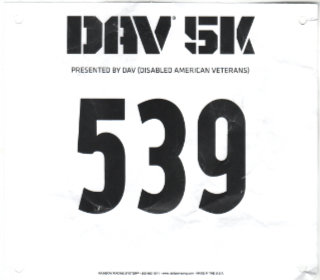 I’ve walked in a DAV 5K every year it has existed. It all started with a single event in Cincinnati in 2013. Six cities hosted events in 2017. Veterans Day fell on Saturday this year, and three of those cities, including Cincinnati, held their 5Ks on that day. The other three took place a week prior.
I’ve walked in a DAV 5K every year it has existed. It all started with a single event in Cincinnati in 2013. Six cities hosted events in 2017. Veterans Day fell on Saturday this year, and three of those cities, including Cincinnati, held their 5Ks on that day. The other three took place a week prior.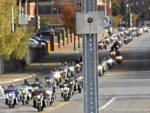
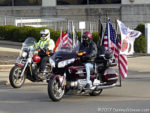
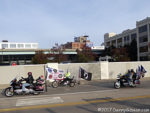 The first official activity of the event is the motorcycle roll-by. I was more or less in position near the back of the pack when I heard them rumbling behind me and turned to snap a picture. Thanks to the magic of auto-focus, I have a rather crisp rendition of the sign post. Somewhat less crisp is the photo’s actual subject matter. I did a little better as they passed by where I stood.
The first official activity of the event is the motorcycle roll-by. I was more or less in position near the back of the pack when I heard them rumbling behind me and turned to snap a picture. Thanks to the magic of auto-focus, I have a rather crisp rendition of the sign post. Somewhat less crisp is the photo’s actual subject matter. I did a little better as they passed by where I stood. The scene in this picture should be familiar to anyone who has followed my DAV 5K career. I’ve posted a photo of the crowd leading me under the start banner every year except the very first, and that year I included a shot of the banner from the other side as the cyclists were about to take off.
The scene in this picture should be familiar to anyone who has followed my DAV 5K career. I’ve posted a photo of the crowd leading me under the start banner every year except the very first, and that year I included a shot of the banner from the other side as the cyclists were about to take off.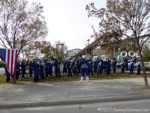
 The temperature at the start was in the 20s and I believe that’s the coldest it has ever been for the event. I’m thinking that may explain the dearth of entertainment or maybe it’s just become old hat. Other than the faithful Saint Xavier Marching Band providing some pep from their usual spot. there was just one musician on the route. He jumped into Lynyrd Skynyrd’s “GimmeThree Steps” as I approached and that was what I was still hearing as I moved out of range.
The temperature at the start was in the 20s and I believe that’s the coldest it has ever been for the event. I’m thinking that may explain the dearth of entertainment or maybe it’s just become old hat. Other than the faithful Saint Xavier Marching Band providing some pep from their usual spot. there was just one musician on the route. He jumped into Lynyrd Skynyrd’s “GimmeThree Steps” as I approached and that was what I was still hearing as I moved out of range.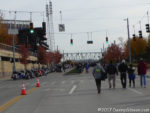 I don’t know whether the motorcycles follow the entire route or take a short cut but a long line of them are parked near the finish each year. The riders stand on the median offering hand slaps and encouragement to all the participants. Not everyone takes advantage of the hand slaps but there aren’t many who couldn’t use a little encouragement at this point.
I don’t know whether the motorcycles follow the entire route or take a short cut but a long line of them are parked near the finish each year. The riders stand on the median offering hand slaps and encouragement to all the participants. Not everyone takes advantage of the hand slaps but there aren’t many who couldn’t use a little encouragement at this point.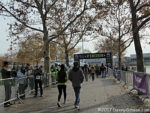 Here is another familiar scene but, unlike the scene at the start banner, the crowd has gotten rather thin. Despite what you’re probably thinking, it’s not because I’ve left them in my dust. There are a few (141) behind me but much more than a few (2147) ahead of me. In an alarming difference from past finishes, my time did not improve over the previous year. This year’s 1:03:55 was a full 19 seconds higher than last year’s time. Although it’s possible that the Tulsa course is itself faster (I did beat my previous Cincinnati time.) I fear that my pace has peaked and the glory days are over.
Here is another familiar scene but, unlike the scene at the start banner, the crowd has gotten rather thin. Despite what you’re probably thinking, it’s not because I’ve left them in my dust. There are a few (141) behind me but much more than a few (2147) ahead of me. In an alarming difference from past finishes, my time did not improve over the previous year. This year’s 1:03:55 was a full 19 seconds higher than last year’s time. Although it’s possible that the Tulsa course is itself faster (I did beat my previous Cincinnati time.) I fear that my pace has peaked and the glory days are over.
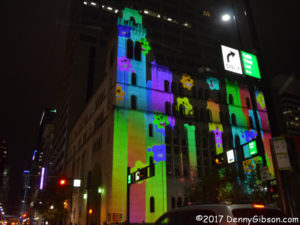
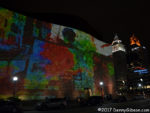

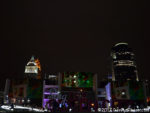
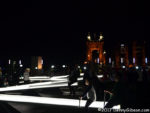
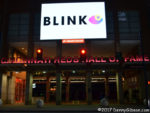
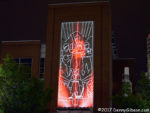
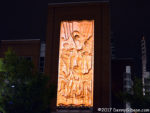
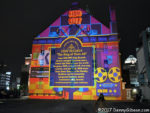


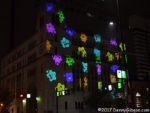
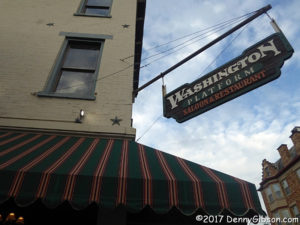
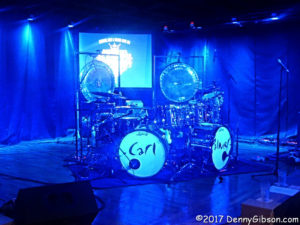
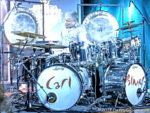

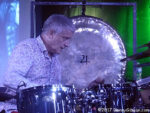
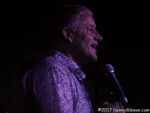

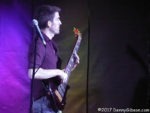
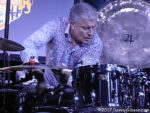
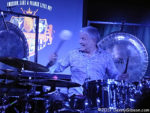


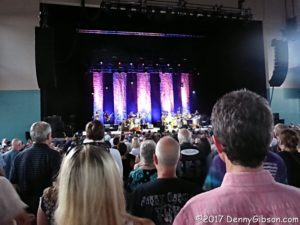

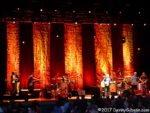
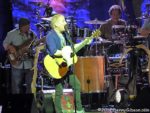
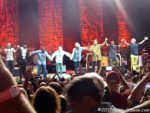
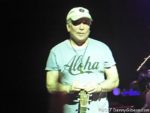
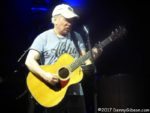
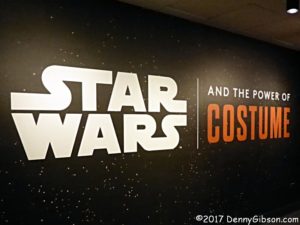

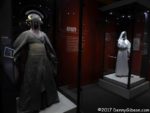
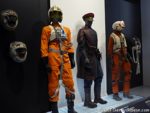
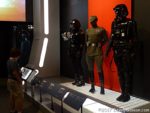
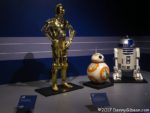
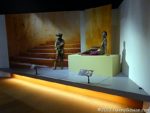
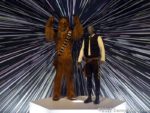
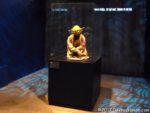
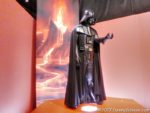
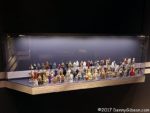
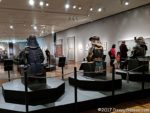
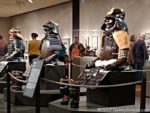
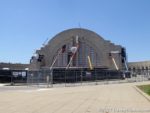
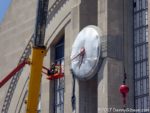





























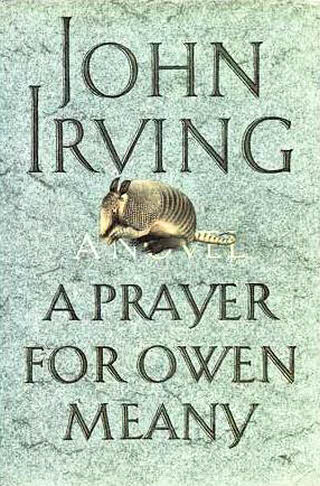 I’m not really going to review this twenty-seven-year-old book that I’m guessing thousands of professional reviewers have written millions of words about. When I first read it, more than two decades ago, I thought it was one of the best books I had ever encountered. A recent re-read only reinforced that. The re-read was prompted by plans to attend a performance of a play based on the novel. I’m going to say some things about that performance but this really isn’t a review of it either. In fact, I find myself stumped in trying to explain just exactly what this is. Whatever it is, it was triggered by my recent experience with a book and a play.
I’m not really going to review this twenty-seven-year-old book that I’m guessing thousands of professional reviewers have written millions of words about. When I first read it, more than two decades ago, I thought it was one of the best books I had ever encountered. A recent re-read only reinforced that. The re-read was prompted by plans to attend a performance of a play based on the novel. I’m going to say some things about that performance but this really isn’t a review of it either. In fact, I find myself stumped in trying to explain just exactly what this is. Whatever it is, it was triggered by my recent experience with a book and a play.